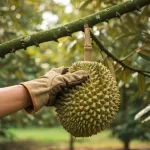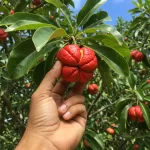| Key Takeaways |
| – Growing peonies from seed is a rewarding and economical way to create new varieties and enjoy fragrant flowers in your garden |
| – Peony seeds need to be harvested, germinated, sown, planted, cared for, and troubleshooted properly to ensure successful growth and blooming |
| – Peony seeds require stratification, which is a treatment that exposes them to cold and moist conditions to break dormancy and stimulate germination |
| – Peony seeds can be sown indoors or outdoors in late winter or early spring, and planted in late summer or early fall in full sun or partial shade |
| – Peony seeds need well-drained, fertile, and slightly acidic soil, regular watering, occasional fertilizing, and protection from frost and pests |
Do you love peonies? These beautiful flowering plants are native to Asia, Europe, and Western North America, and they come in many varieties and colors. Peonies are also popular ornamental plants and cut flowers, and they have some medicinal uses in traditional Chinese medicine.
Peonies are usually propagated by division or grafting, but did you know that you can also grow them from seed? Growing peonies from seed is a rewarding and economical way to create new varieties and enjoy fragrant flowers in your garden. However, it is not as easy as planting any other seed. Peony seeds need special care and attention to germinate and grow.
In this article, we will show you how to grow a peony from seed step by step. We will cover everything you need to know about harvesting, germinating, sowing, planting, caring for, and troubleshooting peony seeds. By following this guide, you will be able to grow your own peonies from seed successfully.
How to Harvest Peony Seeds
The first step to growing peonies from seed is to harvest the seeds from the seed pods. The seed pods are the swollen parts of the flower that remain after the petals fall off. They usually contain several seeds inside.
To harvest peony seeds, you need to wait until the seed pods are ripe and ready to be collected. This usually happens in late summer or early fall when the seed pods turn brown and start to crack open. You can also test the ripeness of the seed pods by gently squeezing them. If they feel soft and spongy, they are ripe.
To collect peony seeds, you need to use some tools such as pruning shears, scissors, knife, paper towel, etc. Here are the steps to harvest peony seeds:
- Cut off the stem of the peony plant that has the ripe seed pod with pruning shears or scissors
- Carefully peel off the outer layer of the seed pod with your fingers or a knife
- Remove the seeds from the seed pod and place them on a paper towel
- Clean the seeds by rubbing off any pulp or debris with your fingers or another paper towel
- Store the seeds in a cool and dry place until ready to germinate
How to Germinate Peony Seeds
The next step to growing peonies from seed is to germinate the seeds. Germination is the process of a seed sprouting and developing into a seedling. However, peony seeds do not germinate easily. They need a special treatment called stratification.
Stratification is a treatment that exposes seeds to cold and moist conditions to break dormancy and stimulate germination. Peony seeds need both cold and warm stratification cycles to germinate properly. This mimics the natural seasons that peonies experience in their native habitats.
There are two types of peony seeds: herbaceous peony seeds and tree peony seeds. Herbaceous peonies are perennial plants that die back in winter and regrow in spring. Tree peonies are woody shrubs that keep their stems year-round. The type of peony seed determines the length and order of stratification cycles.
Herbaceous peony seeds need two cold stratification cycles followed by one warm stratification cycle. The first cold cycle lasts for 3 months at 0°C (32°F), the second cold cycle lasts for 3 months at 4°C (39°F), and the warm cycle lasts for 3 months at 15°C (59°F).
Tree peony seeds need one warm stratification cycle followed by one cold stratification cycle. The warm cycle lasts for 3 months at 15°C (59°F), and the cold cycle lasts for 3 months at 4°C (39°F).
There are different methods of stratification for peony seeds, such as:
- Cold moist stratification in refrigerator or freezer
- Warm moist stratification in ziplock bag or container
- Cold dry stratification in sand or vermiculite
- Warm dry stratification in paper envelope or cloth bag
The most common and effective method of stratification for peony seeds is cold moist stratification in refrigerator or freezer. This method involves placing the seeds in a moist medium such as peat moss, sand, compost, or paper towel, and sealing them in a ziplock bag or a container. The bag or container is then placed in the refrigerator or freezer for the required duration of the cold cycle. The temperature and moisture levels are checked regularly to ensure optimal conditions. The seeds are then moved to a warmer location such as a windowsill or a greenhouse for the warm cycle.
Here are the step-by-step instructions on how to stratify peony seeds using this method:
- Prepare the seeds by soaking them in water for 24 hours to soften the seed coat and activate the embryo
- Drain the water and place the seeds in a ziplock bag or a container with a moist medium such as peat moss, sand, compost, or paper towel
- Label the bag or container with the date and the type of peony seed
- Seal the bag or container and place it in the refrigerator or freezer for the first cold cycle (3 months for herbaceous peony seeds, skip this step for tree peony seeds)
- After the first cold cycle, move the bag or container to a warmer location such as a windowsill or a greenhouse for the warm cycle (3 months for both herbaceous and tree peony seeds)
- After the warm cycle, place the bag or container back in the refrigerator or freezer for the second cold cycle (3 months for herbaceous peony seeds, skip this step for tree peony seeds)
- After the second cold cycle, check the seeds for signs of germination such as root emergence or sprout formation
How to Sow Peony Seeds
The third step to growing peonies from seed is to sow the seeds. Sowing is the process of placing the seeds in soil or another growing medium to grow into plants. Peony seeds can be sown indoors or outdoors depending on your preference and climate.
The best time to sow peony seeds is in late winter or early spring when the temperature is mild and stable. This allows the seeds to establish themselves before the summer heat and winter frost. The best location to sow peony seeds is in a sunny and sheltered spot that has good air circulation and drainage.
To sow peony seeds, you need to prepare the soil and containers properly. Peony seeds need well-drained, fertile, and slightly acidic soil with a pH of 6.0 to 7.0. You can use a potting mix that contains peat moss, sand, compost, perlite, vermiculite, loam, etc. You can also add some organic matter such as manure, bone meal, blood meal, etc. to enrich the soil.
You can sow peony seeds in different types of containers such as seed trays, pots, cell packs, etc. The containers should have drainage holes at the bottom and be large enough to accommodate the seedlings. You should also label each container with the date and the type of peony seed.
Here are the step-by-step instructions on how to sow peony seeds:
- Fill each container with moist potting mix up to 2 cm (0.8 inch) below the rim
- Make a small hole in the center of each container with your finger or a pencil
- Place one peony seed in each hole and cover it lightly with potting mix
- Water each container gently until water drains out from the bottom
- Cover each container with plastic wrap or a clear lid to create a mini greenhouse effect
- Place each container in a sunny and warm location such as a windowsill or a greenhouse
How to Plant Peony Seeds
The fourth step to growing peonies from seed is to plant the seeds. Planting is the process of transferring the seedlings from the containers to their permanent location in your garden. Peony seedlings need to be planted when they have developed at least two pairs of true leaves.
The best time to plant peony seedlings is in late summer or early fall when the temperature is cool and stable. This allows the seedlings to establish themselves before the winter dormancy and spring growth. The best location to plant peony seedlings is in full sun or partial shade that has good air circulation and drainage.
To plant peony seedlings, you need to transplant them from the containers to the garden using tools such as trowel, shovel, etc. Here are the step-by-step instructions on how to plant peony seedlings:
- Choose a suitable spot in your garden that has full sun or partial shade, good air circulation, and drainage
- Prepare the soil by digging a hole that is twice as wide and deep as the container of the seedling
- Add some organic matter such as compost, manure, bone meal, blood meal, etc. to the bottom of the hole and mix it with the soil
- Carefully remove the seedling from the container by gently squeezing the sides and tapping the bottom
- Place the seedling in the center of the hole and spread its roots evenly
- Fill the hole with soil and press it firmly around the seedling
- Water the seedling thoroughly until water drains out from the bottom
- Repeat the process for each seedling, leaving at least 30 cm (12 inches) of space between them
- Apply a layer of mulch such as straw, bark, leaves, etc. around the seedlings to conserve moisture and prevent weeds
- Protect the seedlings from frost and pests by covering them with a cloche, a net, or a fence
How to Care for Peony Seeds
The fifth step to growing peonies from seed is to care for the seeds. Caring is the process of maintaining and improving the health and growth of the plants. Peony seeds need basic needs and preferences such as soil pH, drainage, moisture, organic matter, light exposure, temperature range, etc.
To care for peony seeds, you need to maintain and improve the soil quality and fertility using materials such as fertilizer, compost, manure, etc. You also need to water, weed, prune, deadhead, etc. your plants regularly. Here are some tips on how to care for peony seeds:
- Water your plants once or twice a week depending on the weather and soil conditions. Avoid overwatering or underwatering your plants as this can cause root rot or drought stress. Water your plants deeply and slowly at the base of the stem and avoid wetting the foliage.
- Fertilize your plants once or twice a year in spring and fall using a balanced fertilizer that contains nitrogen, phosphorus, and potassium. Avoid overfertilizing or underfertilizing your plants as this can cause nutrient burn or deficiency. Follow the instructions on the fertilizer package and apply it around the drip line of your plants.
- Weed your plants regularly by removing any unwanted plants that compete with your peonies for space, water, nutrients, and light. Use a hoe or a hand weeder to pull out the weeds by their roots and dispose of them properly. Avoid using herbicides or pesticides on your plants as they can harm them or reduce their flowering.
- Prune your plants in late winter or early spring before they start growing new shoots. Remove any dead, diseased, damaged, or crossing branches with pruning shears or scissors. Cut them back to a healthy bud or branch and make clean and angled cuts. This will improve air circulation and prevent disease.
- Deadhead your plants in summer after they finish blooming. Remove any faded or spent flowers with pruning shears or scissors. Cut them back to a leaf node or a lateral bud and make clean and angled cuts. This will prevent seed formation and encourage more blooming.
How to Troubleshoot Peony Seeds
The sixth step to growing peonies from seed is to troubleshoot the seeds. Troubleshooting is the process of identifying, diagnosing, and treating the problems and challenges that may arise when growing peonies from seed. Peony seeds may face some common problems such as poor germination rate, low viability rate, slow growth rate, no bloom, disease, pest, etc.
To troubleshoot peony seeds, you need to identify diagnose and treat the problems using tools such as viability test fungal spray insecticide etc. You also need to adjust temperature moisture light etc. according to your plants’ needs. Here are some tips on how to troubleshoot peony seeds:
- Poor germination rate: This means that only a few or none of your seeds germinate after stratification and sowing. This can be caused by several factors such as old or damaged seeds improper stratification conditions inadequate sowing depth insufficient moisture etc. To solve this problem you can do a viability test before stratification by placing some seeds in water for 24 hours. If they sink they are viable if they float they are not viable discard them. You can also improve your stratification conditions by checking and adjusting temperature moisture light etc regularly You can also sow your seeds at a depth of 0 5 cm (0 2 inch) and keep them moist but not soggy.
- Low viability rate: This means that only a few or none of your seeds produce viable plants after germination and planting. This can be caused by several factors such as genetic variation hybridization self-pollination environmental stress etc. To solve this problem you can choose seeds from reputable sources that are true to type and not hybridized. You can also avoid self-pollination by planting different varieties of peonies at least 30 m (100 feet) apart. You can also reduce environmental stress by providing optimal conditions for your plants such as soil pH drainage moisture organic matter light exposure temperature range etc.
- Slow growth rate: This means that your plants grow very slowly or not at all after planting and caring. This can be caused by several factors such as poor soil quality low fertility competition overcrowding etc. To solve this problem you can improve your soil quality and fertility by adding organic matter such as compost manure bone meal blood meal etc. You can also reduce competition and overcrowding by weeding your plants regularly and spacing them at least 30 cm (12 inches) apart.
- No bloom: This means that your plants do not produce any flowers after planting and caring. This can be caused by several factors such as immature plants insufficient light excessive nitrogen late frost early heat etc. To solve this problem you can be patient and wait for your plants to mature as peonies usually take 3 to 5 years to bloom from seed. You can also provide sufficient light by planting your peonies in full sun or partial shade. You can also avoid excessive nitrogen by using a balanced fertilizer that contains phosphorus and potassium. You can also protect your plants from late frost and early heat by covering them with a cloche a net or a fence.
Conclusion
Growing peonies from seed is a rewarding and economical way to create new varieties and enjoy fragrant flowers in your garden. However, it is not as easy as planting any other seed. Peony seeds need special care and attention to germinate and grow.
In this article, we have shown you how to grow a peony from seed step by step. We have covered everything you need to know about harvesting, germinating, sowing, planting, caring for, and troubleshooting peony seeds. By following this guide, you will be able to grow your own peonies from seed successfully.
We hope you enjoyed this article and learned something new. If you have any questions or feedback, please let us know in the comments below. If you have tried growing peonies from seed, please share your experience with us. We would love to hear from you.
Happy gardening! ????







